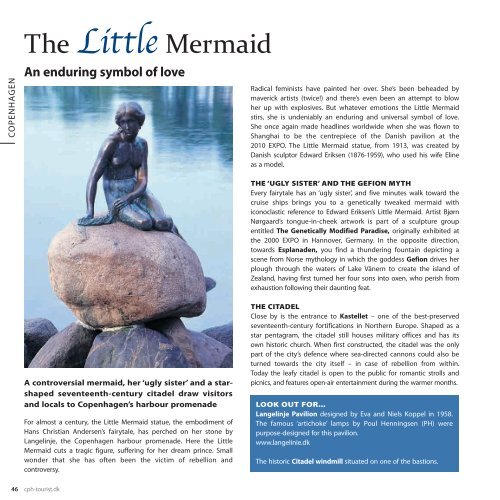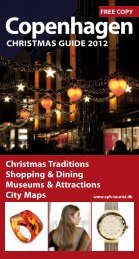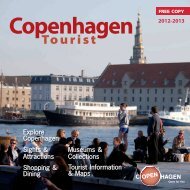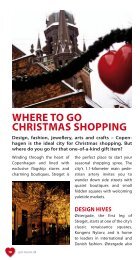eat style oughout enturies - Copenhagen Tourist
eat style oughout enturies - Copenhagen Tourist
eat style oughout enturies - Copenhagen Tourist
You also want an ePaper? Increase the reach of your titles
YUMPU automatically turns print PDFs into web optimized ePapers that Google loves.
<strong>Copenhagen</strong><br />
The Little Mermaid<br />
An enduring symbol of love<br />
A controversial mermaid, her ‘ugly sister’ and a starshaped<br />
seventeenth-century citadel draw visitors<br />
and locals to <strong>Copenhagen</strong>’s harbour promenade<br />
For almost a century, the Little Mermaid statue, the embodiment of<br />
hans Christian andersen’s fairytale, has perched on her stone by<br />
Langelinje, the <strong>Copenhagen</strong> harbour promenade. here the Little<br />
Mermaid cuts a tragic figure, suffering for her dream prince. Small<br />
wonder that she has often been the victim of rebellion and<br />
controversy.<br />
46 cph-tourist.dk<br />
Radical feminists have painted her over. She’s been beheaded by<br />
maverick artists (twice!) and there’s even been an attempt to blow<br />
her up with explosives. But whatever emotions the Little Mermaid<br />
stirs, she is undeniably an enduring and universal symbol of love.<br />
She once again made headlines worldwide when she was flown to<br />
Shanghai to be the centrepiece of the Danish pavilion at the<br />
2010 eXpo. The Little Mermaid statue, from 1913, was cr<strong>eat</strong>ed by<br />
Danish sculptor edward eriksen (1876-1959), who used his wife eline<br />
as a model.<br />
The ‘ugly sisTeR’ AnD The gefion myTh<br />
every fairytale has an ‘ugly sister’, and five minutes walk toward the<br />
cruise ships brings you to a genetically tweaked mermaid with<br />
iconoclastic reference to edward eriksen’s Little Mermaid. artist Bjørn<br />
nørgaard’s tongue-in-cheek artwork is part of a sculpture group<br />
entitled The Genetically Modified Paradise, originally exhibited at<br />
the 2000 eXpo in hannover, germany. In the opposite direction,<br />
towards Esplanaden, you find a thundering fountain depicting a<br />
scene from norse mythology in which the goddess Gefion drives her<br />
plough through the waters of Lake Vänern to cr<strong>eat</strong>e the island of<br />
Zealand, having first turned her four sons into oxen, who perish from<br />
exhaustion following their daunting f<strong>eat</strong>.<br />
The CiTADel<br />
Close by is the entrance to Kastellet – one of the best-preserved<br />
seventeenth-century fortifications in northern europe. Shaped as a<br />
star pentagram, the citadel still houses military offices and has its<br />
own historic church. When first constructed, the citadel was the only<br />
part of the city’s defence where sea-directed cannons could also be<br />
turned towards the city itself – in case of rebellion from within.<br />
Today the leafy citadel is open to the public for romantic strolls and<br />
picnics, and f<strong>eat</strong>ures open-air entertainment during the warmer months.<br />
look ouT foR...<br />
Langelinje Pavilion designed by eva and niels Koppel in 1958.<br />
The famous ‘artichoke’ lamps by poul henningsen (ph) were<br />
purpose-designed for this pavilion.<br />
www.langelinie.dk<br />
The historic Citadel windmill situated on one of the bastions.






